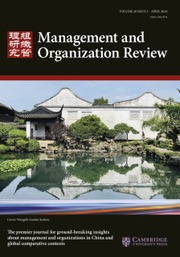No CrossRef data available.
Article contents
Isolating the Effect of Social Risk on MNEs’ CSR Reporting: A New Approach Based on China's Belt & Road Initiative
Published online by Cambridge University Press: 13 September 2024
Abstract
This article highlights CSR disclosure as a strategic response of Chinese multinational enterprises (MNEs) to the social risk they face in host countries. Deviating from prior research that aims to directly measure social risk, we offer a new approach to isolate the effect of social risk by leveraging China's Belt & Road Initiative (BRI) as the research context, under which Chinese MNEs are largely protected from political risk in membership countries but are exposed to substantial social risk from local nongovernment stakeholders. Results from difference-in-differences analyses show that after the enactment of the BRI, Chinese MNEs investing in BRI countries significantly increases their likelihood of CSR disclosure than that of their counterparts investing in non-BRI countries. Further, such effects are more pronounced for state-owned MNEs and MNEs in natural resource industries. This research enriches the international business literature on the relationship between political risk and social risk, and that between corporate political actions and corporate social responsibility.
摘要
本文认为,企业社会责任披露是中国跨国公司一种应对东道国社会风险的战略手段。与以往直接衡量社会风险的研究不同,本文以中国‘一带一路’倡议为研究背景,提出了鉴别社会风险影响的新方法。虽然中国跨国公司在‘一带一路’沿线国家的投资使它们免受来自东道国政府的政治风险,但却仍面临着来自当地非政府利益相关者的社会风险。这一背景有助于我们鉴别社会风险,并研究其对跨国公司企业社会责任披露的影响。通过双重差分法分析,本研究发现:在‘一带一路’沿线国家投资的中国跨国公司比那些不在‘一带一路’沿线国家投资的中国跨国公司,更可能提高企业社会责任的披露;而且这种影响对国有跨国公司和自然资源行业的跨国公司更为明显。本文丰富了国际商务文献中关于政治风险与社会风险、企业政治行为与企业社会责任关系的研究
Keywords
- Type
- Article
- Information
- Copyright
- Copyright © The Author(s), 2024. Published by Cambridge University Press on behalf of International Association for Chinese Management Research


